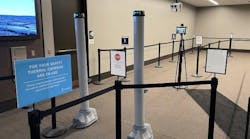Federal aviation officials this week plan to start a test program at Denver International Airport's north terminal checkpoint steering "expert" travelers - those who travel frequently and with little luggage - to a screening line marked by a black diamond sign.
Following the ski-slope theme, "casual" travelers with multiple carry-on bags will be encouraged to use the special screening line with the blue sign, and families, groups and those with special needs should consider the more leisurely screening line designated by a green sign.
"As much as business travelers want to move through quickly, another group of passengers does not want to feel pressured," said Transportation Security Administration spokeswoman Carrie Harmon.
The two-week TSA test program begins Wednesday.
Only three of the 10 screening lines at the DIA checkpoint will be involved in the test, and travelers will "self-select" which line they want to take, Harmon said.
"Black diamond" screening, as it is called, started as a test at Salt Lake City's airport last week. DIA is the second U.S. airport to experiment with the test, which is designed to ease the flow of travelers through airport checkpoints.
Visiting Denver on Monday, TSA chief Kip Hawley outlined new measures and technologies aimed at countering security threats.
He told a new crop of security screeners for DIA that al-Qaeda operatives are likely to be going through U.S. airport checkpoints on surveillance missions and "one day they will come through with a bomb."
"There may be only one moment in a career" to stop such a threat, Hawley told the 40 recruits in a pep talk before swearing them in as new TSA employees.
To help counter threats, innovation in screening technology will be coming to DIA and other U.S. airports, Hawley said.
One promising device is advanced technology X-ray equipment for checkpoint screeners that generates multiple X-ray angles of carry-on bags instead of current machines that offer a single, top-down X-ray view, according to TSA.
A number of federal audits have faulted TSA screeners for allowing too many weapons and bomb components to pass undetected through airport checkpoints when they were planted to test the effectiveness of the current screening system.
Hawley cited a key advantage of the advanced technology X-ray - its software can be reprogrammed and upgraded to help meet the changing nature of security threats.
Another new technology is whole-body imaging of passengers using millimeter-wave technology, Hawley said.
With millimeter-wave screening, travelers enter a portal where beams of radio-frequency energy are projected over the body surface to create a three-dimensional image of an electronically stripped-down body on a remote monitor, according to TSA's description of the technology.
The aim is to reveal weapons or explosives devices that might be hidden on a body.
Some say whole-body imaging violates the privacy of passengers.
TSA says passengers' faces are blurred to protect privacy, screeners only review the body images from remote locations and images are deleted immediately after they are viewed.
Whole-body imaging has been tested at Phoenix Sky Harbor International Airport, and tests are expected to be extended to Los Angeles International Airport, Baltimore-Washington International and New York's Kennedy International.
So far, whole-body imaging has primarily been used as a secondary screening technique, in lieu of a hand pat down of passengers who set off an alarm at a metal detector and require further screening.
Hawley said millimeter-wave portals offer the potential of being used for the "primary," or initial, screening of passengers.


